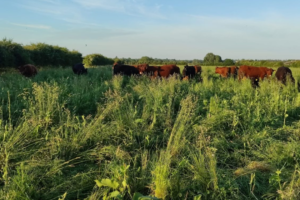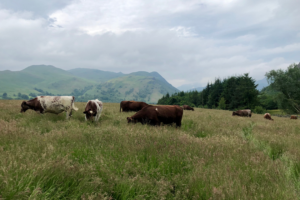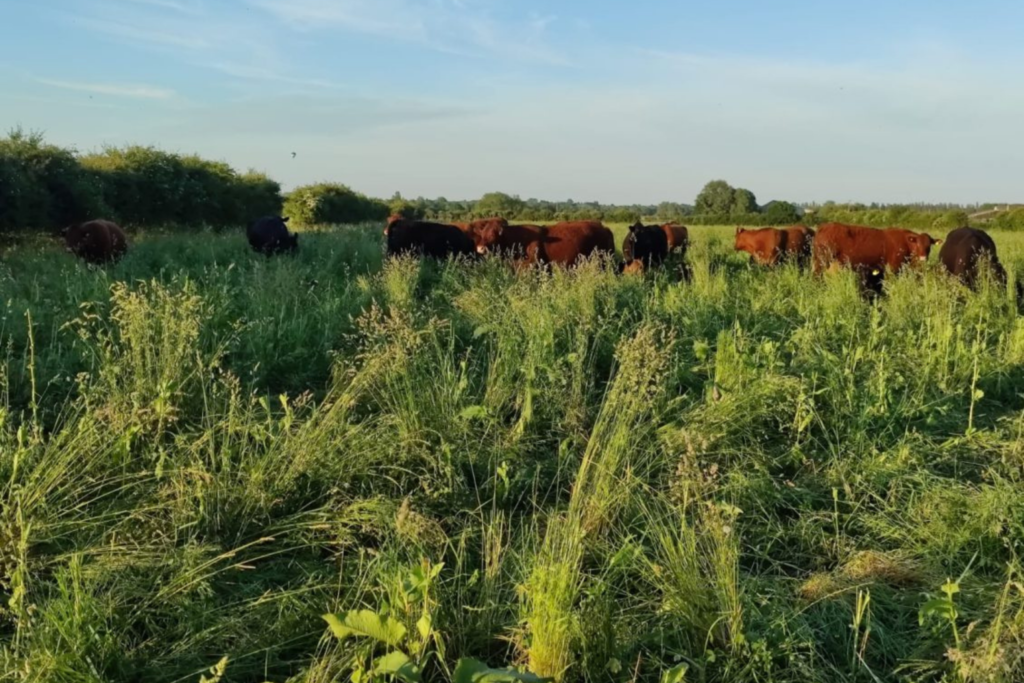Why regenerative agriculture?
In regenerative agriculture, we redefine productivity to consider it in the broader sense across the whole farm system. The output doesn’t come from an increase in inputs but from buffering and stabilising production, so it’s more consistent throughout the year.
By reducing flood and drought, optimising nutrient cycling, maximising photosynthesis and enhancing the health of the livestock, wildlife, and people on the farm, we can create a farming system that has minimised costs whilst increasing the quality and often quantity of its outputs.
In regenerative agriculture, we take an agroecological approach which means we mimic nature and ecosystems with our management.
Natural ecosystems are highly productive and require no external inputs – they run on sunshine and rainfall so are the original renewable system. Pests and diseases are reduced and balanced out because the system is complex, self-organising and is always trying to advance and adapt to its conditions.
When we try to predict outcomes or control and regulate the system, we lose these properties that benefit our regenerative system.

Regenerative agriculture – Principle-based management.
When managing this level of complexity, it works best to be guided by some key ecological principles rather than being fixed by rules or routine plans and prescriptions. This allows us to accommodate every farming context’s uniqueness and provides for the continually fluctuating patterns of nature – something that is becoming more extreme due to climate change.
So how do you know if you are regenerative?
The only real way of knowing if you are regenerative is to measure your ecological outcomes.
Nature doesn’t categorise or segment living systems, but it helps if we group processes to consider and communicate our regenerative progress more readily.
We do this by monitoring these four ecosystem processes and understanding the networks that weave them together.
- Water cycle
- Nutrient cycle
- Photosynthesis
- Airflow
- All of which are woven together by nature’s dynamic networks.

Ecological principles
“The biggest threat to humanity is our inability to manage complexity” (Alan Savory)
The survival of our societies and economies depend on the earth and its ecosystem processes. Good management depends on the full consideration and integration of ecological, social and economic factors in the short and long term.
The following seven ecological principles can help guide our management:
Networks: nature is a network of interconnected living systems
In regenerative agriculture, we adopt a whole system approach where networks of plants, animals and people generate outputs greater than the sum of the parts.
Energy: Sunlight is the fundamental source of energy that drives all ecological cycles.
In regenerative agriculture systems, we increase primary production by improving photosynthetic capacity and rate. In doing so, we increase the carbon available to the system making more food available for soil organisms, plants, animals and people.
Cycles: water and nutrients cycle continuously through living systems; hence ecosystems do not generate waste.
In regenerative agriculture, we aim to reduce the need for inputs by creating closed-loop nutrient cycles. We increase water cycles’ effectiveness to buffer saturation and drought to get more consistent production throughout the year.
Relationships: exchanges of energy and resources in an ecosystem are sustained by a wide range of interrelations and partnerships.
In a regenerative agriculture system, we enhance beneficial biological relationships harnessing the productive power of complementarity and synergy for a more efficient and productive method. We build a network of people to further knowledge, lean on for support, and share resources.
Diversity: all ecosystems derive stability and resilience through the richness of diversity.
In regenerative agriculture systems, we add and expand rather than remove, reduce or control. We leverage the power of diversity and connectance = complexity for balancing out pests, disease and building a resilient, consistently productive output.
In our regenerative communities, we encourage a diversity of skills, cultures, gender and backgrounds.
Adaptation: an ecosystem is a flexible, ever-fluctuating network that adapts to its environment.
In regenerative agriculture systems, our management is adaptive and disruptive. We avoid repetitive management patterns; we mimic nature’s functions and seek to become part of the system. Through continual observation, we monitor feedback and respond to changes quickly and effectively to increase our capacity for resilience.
Succession: Nature is always trying to advance in ecological succession.
In regenerative agriculture systems, we work with nature to cover bare soil and help our ecosystem build complexity to become stable and resilient.
Ecological succession starts when plant communities cover bare rock with lichens and mosses and pioneering species, then builds in diversity until it becomes stable and self-perpetuating.
Every plant and animal has a preferred stage of succession. By advancing the stage of ecological succession of our system, we can create the conditions for the plants and animals we want, and make the conditions unfavourable for those species, which cause us problems.
